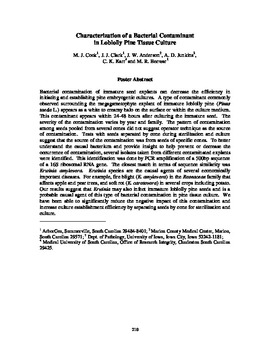| dc.contributor.author | Cook, M. J. | |
| dc.contributor.author | Clark, J. J. | |
| dc.contributor.author | Anderson, J. W. | |
| dc.contributor.author | Junkins, A. D. | |
| dc.contributor.author | Karr, C. K. | |
| dc.contributor.author | Becwar, M. R. | |
| dc.date.accessioned | 2016-04-25T19:36:07Z | |
| dc.date.available | 2016-04-25T19:36:07Z | |
| dc.date.issued | 2003 | |
| dc.identifier | oksd_sf27_p210.pdf | |
| dc.identifier.citation | Cook, M. J., Clark, J. J., Anderson, J. W., Junkins, A. D., Karr, C. K., & Becwar, M. R. (2003). "Characterization of a Bacterial Contaminant in Loblolly Pine Tissue Culture." In 27th Southern Forest Tree Improvement Conference, Stillwater, OK | |
| dc.identifier.uri | https://hdl.handle.net/11244/33701 | |
| dc.description.abstract | Bacterial contamination of immature seed explants can decrease the efficiency in initiating and establishing pine embryogenic cultures. A type of contaminant commonly observed surrounding the megagametophyte explant of immature loblolly pine (Pinus taeda L.) appears as a white to creamy halo on the surface or within the culture medium. This contaminant appears within 24-48 hours after culturing the immature seed. The severity of the contamination varies by year and family. The pattern of contamination among seeds pooled from several cones did not suggest operator technique as the source of contamination. Tests with seeds separated by cone during sterilization and culture suggest that the source of the contamination was from seeds of specific cones. To better understand the causal bacterium and provide insight to help prevent or decrease the occurrence of contamination, several isolates taken from different contaminated explants were identified. This identification was done by PCR amplification of a 500bp sequence of a 16S ribosomal RNA gene. The closest match in terms of sequence similarity was Erwinia amylovora. Erwinia species are the causal agents of several economically important diseases. For example, fire blight (E. amylovora) in the Roseaceae family that affects apple and pear trees, and soft rot (E. carotovora) in several crops including potato. Our results suggest that Erwinia may also infect immature loblolly pine seeds and is a probable causal agent of this type of bacterial contamination in pine tissue culture. We have been able to significantly reduce the negative impact of this contamination and increase culture establishment efficiency by separating seeds by cone for sterilization and culture. | |
| dc.format | application/pdf | |
| dc.language | en_US | |
| dc.relation.ispartofseries | Sponsored publication . . . of the Southern Forest Tree Improvement Committee ; no. 49 | |
| dc.rights | This paper is made available through open access and the auspices of the fair use doctrine for scholarly, educational and research purposes while recognizing the publisher already offers a free online version. The OSU Library�s intent is to offer access and preserve publications involving its faculty contributions. Contact the Digital Resources and Discovery Services at lib-dls@okstate.edu or 405-744-9161 for the permission policy on the use, reproduction or distribution of this material. | |
| dc.source | Proceedings of the 27th Southern Forest Tree Improvement Conference, volume 27, 2003. Editor, Craig R. McKinley. | |
| dc.title | Characterization of a Bacterial Contaminant in Loblolly Pine Tissue Culture | |
| dc.type | text | |
| osu.filename | oksd_sf27_p210.pdf | |
| dc.type.genre | Conference proceedings | |
| dc.description.scopeandcontents | Papers and abstracts from the 27th Southern Forest Tree Improvement Conference held at Oklahoma State University in Stillwater, Oklahoma on June 24-27, 2003. | |
